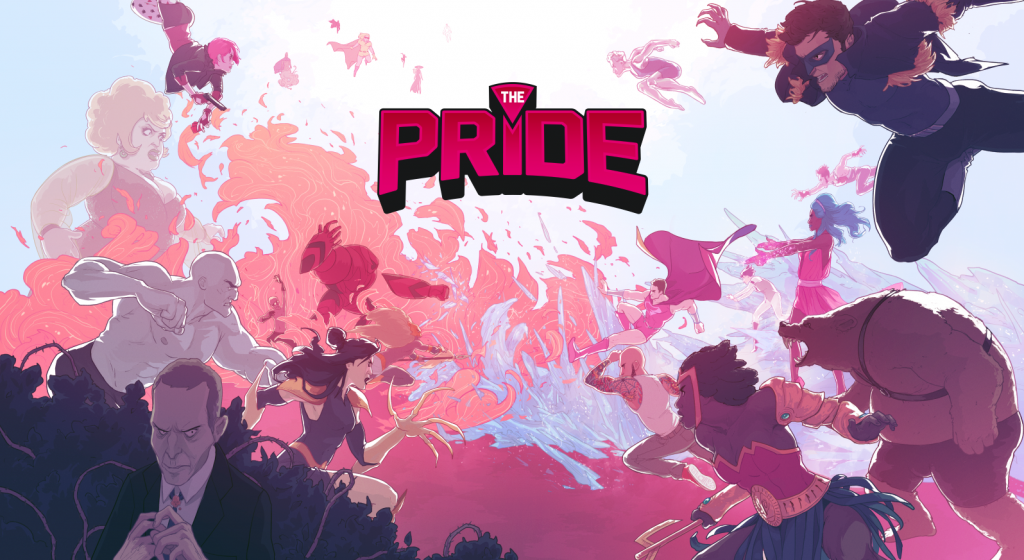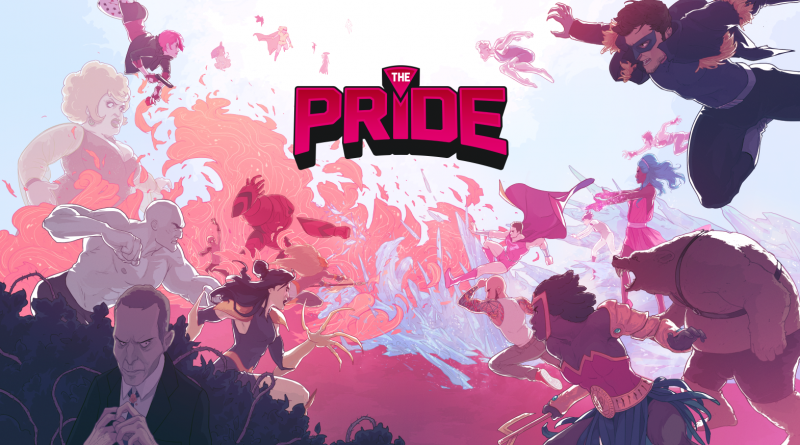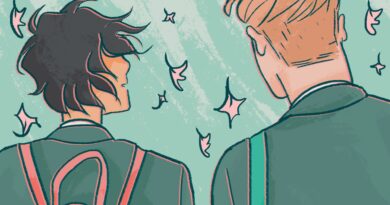Comics Corner: Meet ‘The Pride’ – comics’ first LGBTQ+ superhero team

Comics and video games go hand in hand. It’s not just the sizeable overlap of their respective fanbases – the Venn diagram of people who play games and read some form of comics is almost a circle. It’s the mediums themselves, sharing a symbiosis that dates almost as far back as the dawn of the games industry.
This is undeniable. We can look back to video games opting to advertise primarily in comics as the industry transitioned from the arcades to home computers or consoles, often with single-page custom-drawn adventures running in issues of Marvel or DC superhero titles. We can find early crossover projects, such as 1984’s almost-forgotten Questprobe, which saw three adventure games focused on the Hulk, Spider-Man, and half of the Fantastic Four matched by a three-issue comic book adaptation. The Legend of Zelda: A Link to the Past received a unique comic book adaptation, originally running in the pages of Nintendo Power magazine in 1992, written and drawn by legendary Japanese manga artist Shotaro Ishinomori exclusively for North American readers.
Years later, comic book creators who grew up with this mingling of media would go on to create their own games – notably, Uncanny X-Men artist Joe Madureira would leave comics to create Darksiders and, more recently, bring his own Battle Chasers series to gaming. Games and comics are now almost perfectly intertwined, one art form inspiring the other and back again, as the upcoming Horizon: Zero Dawn sequel comic shows.
If comics and games go hand in hand though, then so too do queer comics and games – and the queer fans of both. Which brings us here, to Comics Corner – Gayming Mag’s new regular column looking at the comics industry. Expect a mix of reviews, interviews with LGBTQ+ creators, spotlights on hidden gems or buried treasures, some lofty waffling on queer comics history, and more. Don’t expect all superheroes, all the time, though – we’ll be looking at every genre and form of comics, from big American publishers to Japanese manga, via webcomics and underground indies. That said, it’s safe to assume the X-Men – with their intrinsic themes of diversity and the struggle for acceptance – will seize a fair amount of the spotlight!

Since Comics Corner launches as part of our DIGIPRIDE celebrations, we’re delighted to kick things off by speaking with Joe Glass, creator of The Pride – comics’ first LGBTQ+ superteam. A love letter to the superhero genre with a queer twist, The Pride features heroes such as FabMan, who expresses a different superpower with each colour of light he generates; Frost, a trans woman with sub-zero powers; Angel, a telepathic drag artist; and Bear, who lives up to his namesake by being a literal giant werebear. Existing in a world where superheroes are common, but LGBTQ+ people face many of the same challenges as in the real world, the team is formed when a number of out and proud heroes band together to protect their own community.
Glass has been working on The Pride for a decade, building it from a self-published passion project to a standout title with a keen following, and in 2019 launched the recently concluded Season Two as an exclusive on digital comics platform ComiXology. Here, we talk about the team’s secret origins, the state of LGBTQ+ representation in superhero comics, and the challenges of bringing an all-gay team to comics.

Gayming Mag: The first standalone issue of The Pride launched back in 2011, but how long had these characters been in mind prior to that?
Joe Glass: I think the very first con I did where I sold Pride content was perhaps in 2010, and that was one of the short stories that wound up in The Pride Adventures. But some of the characters were running round my head from back when I was 15 years old. FabMan, Wolf and Bear existed even way back then.
Gayming Mag: You’re obviously a big aficionado of the superhero genre – how would you describe the landscape in terms of LGBTQ+ representation when you were first developing The Pride?
Joe Glass: So back when the initial characters and kernel of an idea formed in my head as a teenager, there wasn’t an awful lot of queer representation in mainstream comics, especially superhero comics. I primarily read X-Men at the time, and looking back there was Northstar – but he wasn’t in any books I read at the fine. Technically, after his coming out, he very quickly vanished from regularly appearing in comics. So part of the reason I wanted to make The Pride was because I wasn’t seeing anything like myself or my community in the comics – and what few there were, they were very often relegated to the background.
Gayming Mag: At around the same time, you had Apollo and Midnighter in Stormwatch and The Authority – essentially a pastiche of Superman and Batman, but gay, correct?
Joe Glass: I mean, I didn’t really see them as a joke. They were certainly playing off a joke (people had made Superman/Batman jokes for years) but Midnighter and Apollo were kinda [writer] Warren Ellis saying “where’s the joke?” in that. He made these two bad ass heroes who just happened to be in a gay relationship. But at the time, I didn’t really have access to The Authority. Where I lived there were no nearby comic stores, and they wouldn’t be exactly mainstream so weren’t anything I had access to until I was in university.
Gayming Mag: Just as Apollo and Midnighter played on the Superman and Batman motifs, were you similarly trying to tap into heroic archetypes with the likes of FabMan presenting the Superman ideal, or Muscle Mary mirroring Wonder Woman, and subverting them with queer identities?
Joe Glass: Absolutely, it’s a big part of why I created the characters that way – to show that queer people can be the heroes too. But it’s also just a handy and useful way to have new characters that new readers can feel like they know to some extent, even if you then subvert some of the expectations they may have for them.

Gayming Mag: In universe, the line-up of The Pride is majority LGBTQ+ but you included one character, Cub, who’s straight. Why was that important to you?
Joe Glass: For Cub, it’s worth to note that he’s the child of a gay man. So, while he isn’t queer himself, he has a queer parent, and that was something not seen much in comics at the time I did it, and that I felt needed to be represented.
But I also don’t believe in segregating the community. That’s not to say I’m into assimilating with mainstream, heteronormative culture, but I don’t believe it helps either party to close ourselves off from each other. So having Cub be part of the team, as a straight person, shows the kind of inclusivity and peace I’d like to see in the world. Plus, it’s a good way to speak back to haters that say I just make straight people villains! Nope, we have this bad-ass straight hero who’s a good guy and perfectly accepting of everyone around him.
Gayming Mag: You crowdfunded the initial run but launched Season Two with Comixology – apart from the general rigours of Kickstarting pretty much anything, have you encountered any resistance in trying to bring The Pride to wider audiences?
Joe Glass: There’s been some pushback. There’s a pretty well known (at least in comics circles) hate group that likes to target me now and again, and have done a few times when I was on Kickstarter. Then there’s also “reviews” now that the series is available on Kindle and ComiXology that essentially amount to “the book’s really gay” which is a bit like, “duh, that’s the point”. A lot of that stuff is just noise, though.
The most troubling pushback I’ve had is from some gay geek audiences who take one look at one character – FabMan – who’s a buff dude in pink hot pants wearing a rainbow cape, and write off the whole series as being problematic or reductive of gay men, or even saying that it’s somehow setting back gay rights and visibility. It’s troubling for a couple reasons. One, it’s literally one character – there are like five very different gay men in The Pride alone. Two, a lot of it was basically anti-camp or anti-femme male representation. I’m sure anyone who’s been in any online gay spaces can tell you about the kind of pushback there is within the gay community to any kind of effeminate personality, even now in 2020.
Thankfully, in terms of companies, I’ve had no pushback. ComiXology have been super supportive, even back when it was self-published and uploaded [independently]. They’ve really pushed to make The Pride a big splash. And as a whole, critical reception and reception from other creators in the industry has been amazing. It’s humbling to have people say The Pride means so much to them, even having compliments from creators I greatly admire. To me, it’s still just the little comic I make in the South Wales valleys because I wanted it. That being said, I think we did amazing stuff in The Pride and I’m very (forgive the pun) proud of it.

Gayming Mag: Were you surprised Comixology rates the comic as suitable for ages 15 and up?
Joe Glass: I think it’s the level of all-ages appropriateness that the standard issue of Avengers or Justice League would be, which is really teens and up. After all, you have to remember, The Pride, while not featuring graphic sex, features some slight nudity, characters in bed together, and – spoiler! – a sex worker superhero in season two.
Gayming Mag: Let’s talk about some of the artists you’ve worked with on the series – starting with your co-creator Gavin Mitchell – how did the two of you start collaborating on The Pride?
Joe Glass: Gavin was actually working with me on another comic project we collaborated on with a couple of other writers and friends, PJ Montgomery and Drew Davies. They were also the ones who convinced me to take this script and idea I’d been working on but wasn’t sure anyone wanted and actually make it. So I asked Gav if he’d be up for doing that too! We were very young and new and the idea of drawing two whole books at the same time seemed entirely possible. Obviously, it was not! But Gav was there for the birth of The Pride and without him, The Pride may never have happened. He brought his wonderful design and artistic sense to really make the series special from the get go.
Gayming Mag: You’ve also had some pretty big name comic artists contribute to the series over the years, including Kris Anka, Marc Ellerby, Sophie Campbell, and more. How did you get them onboard?
Joe Glass: I’ve been blessed with the artists I’ve had the chance to work with throughout the whole series, like Maxine Garbarini, Cem Iroz, Héctor Barros – and yeah, some of them either became big names or were big names from the start. As to how I got them – I asked. It’s really as simple as that. I asked, and told them about the project, and I think they could all see what was important and special in what The Pride was setting out to do. So thankfully they all agreed to be part of it, and the series has been blessed for their involvement.
Gayming Mag: Finally then – what’s next for The Pride?
Joe Glass: Well, hopefully The Pride Season Three – I’m hoping we can get underway on that soon. In the meantime, I released a one-shot comic called Acceptable Losses which is available on ComiXology now or in print via my website. I’m hopefully launching a new Kickstarter soon for a new project, a super queer original graphic novel called Glitter Vipers. I’ve also already teased that there’s another Kickstarter comic series in my future, called The Miracles. That’s all I can say on that last one for now.
Also, I’ve been working with Gavin Mitchell again to create Instagram comics with Manila Luzon, of RuPaul’s Drag Race fame, to tie in to her new single, so follow her Instagram for that!
You can follow Joe on Twitter, and at his website. Check out all three current volumes of The Pride – Season One, Season Two, and standalone tales in The Pride Adventures – on ComiXology here.




